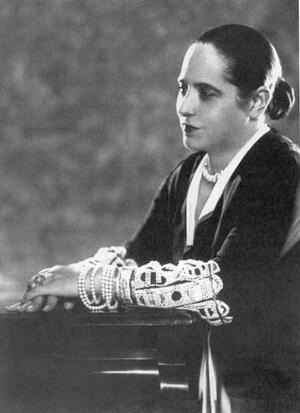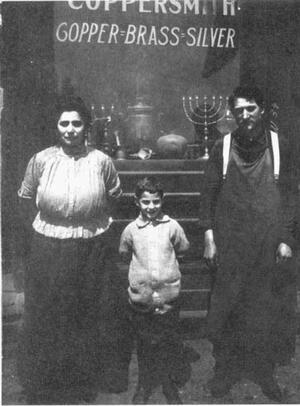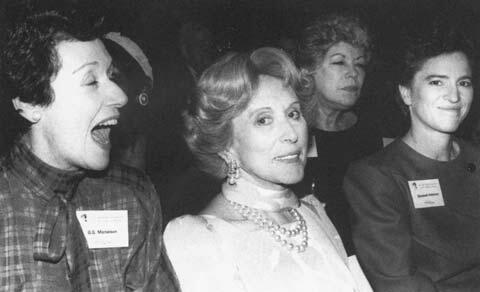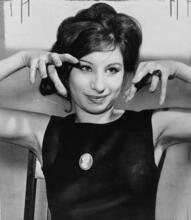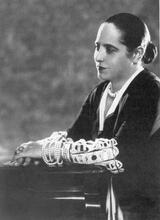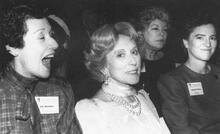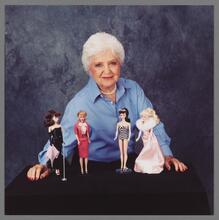Advertising and Consumer Culture in the United States
When Helena Rubinstein died at the age of ninety-four, she left behind an international cosmetics business worth millions, and the foundation she established to fund the arts.
Institution: The Jacob Rader Marcus Center of the American Jewish Archives, Cincinnati, OH, www.americanjewisharchives.org and Studio Lipnitzki
Jewish women played a disproportionate role in the development of American consumer culture in the twentieth century. The late nineteenth century saw the emergence of the modern corporation, the rise of the department store and mail-order companies, and whole new consumer industries, many of which were open to entrepreneurs with limited capital. America Jews were disproportionately involved in commercial pursuits, ranging from clothing to furniture to real estate to movies, and Jewish women in particular were more involved in commerce than women of most other groups and seemed particularly responsive to the sophisticated new material world they discovered in America. In the fields of resorts, women’s wear, cosmetics, toys, film-production, and advertising, Jewish women have stood among the nation’s most significant entrepreneurs and executives.
Introduction
In the twentieth century, Jewish women played a disproportionate role in the development of American consumer culture because of a combination of factors. For one, American industry became increasingly consumer-oriented, and consumer industries were comparatively open to small entrepreneurs. For another, Jewish immigrants and their children tended to display strong entrepreneurial tendencies.
One of the most significant shifts in American business took place in the last decades of the nineteenth century with the emergence of the “modern corporation,” which sought to attract and retain consumers through new forms of packaging, marketing, and advertising. These decades also witnessed the rise of the great department stores and mail-order companies. In addition, whole new consumer industries developed rapidly after the 1870s, particularly cosmetics, women’s ready-made clothing, and resorts. Unlike certain other fields, such as packaged foods, which were dominated by several huge firms, these new areas remained open to entrepreneurs with limited capital. Underlying all of these specific business developments was the nation’s preeminence as a consumer-oriented economy and society. The constantly increasing demand of a rapidly growing and comparatively affluent population made the United States a mecca for enterprising merchants and manufacturers.
As elsewhere, Jews in America were disproportionately involved in commercial pursuits, ranging from clothing to furniture to real estate to movies. One of the outstanding features of the populous Jewish neighborhoods in New York City during the great era of immigration was the corresponding density of retail stores of all types. As well, street markets in these neighborhoods became so sophisticated that they sold specialized luxuries such as fur coats.
While the great majority of merchants and entrepreneurs were men, Jewish women gained an unusual entree into this field of activity. There were two essential reasons for their participation. First, Jewish women traditionally had been more involved in commerce than women of most other groups. It is significant that the well-known and often repeated passage from Proverbs about the “Woman of Valor” depicts a wife and mother who buys vineyards while keeping her family properly fed, clothed, and nurtured. Whereas most ethnic groups had fairly conservative views about the propriety of women being involved in the public sphere, Jews seemed to accept an extraordinary degree of female participation in political, organizational, economic, intellectual, and public leisure activities. Thus, the idea of women being active in the selling of goods did not threaten Jewish sensibility and customs. In fact, the important role of women in commerce, which seemed to persist in Eastern Europe, increased during periods of economic duress. During the period of mass emigration, eyewitness accounts of Jewish life in the Pale of Settlement attested that women were frequently involved in trade.
Second, Jewish women seemed to be particularly responsive to the sophisticated new material world they discovered in America. The turn-of-the-century New York Yiddish press abounded with references to the enthusiasm of Jewish women, even the newly arrived, for the latest styles of dress and interior decoration. Furthermore, there were certain clear contrasts between Jews and other groups in respect to the consumption of goods. Advertisements of major American companies such as Borden’s and Nabisco appeared more rapidly in the Yiddish press than in the foreign-language newspapers of other immigrants, suggesting that these companies quickly identified Jews, and especially Jewish women, as a strong prospective market for national brands. This attraction to new kinds of products and pleasures also contributed to the rapid development of a resort culture among Jews, which set them apart not only from other immigrants but from virtually all Americans of similarly modest means. From a combination of distinctive cultural, economic, and social characteristics, therefore, Jewish women emerged as potent agents of assimilation who identified the use of new products as an important way of participating in American life.
Published research on women in American business is still scarce. As a result, many commercial ventures by Jewish women throughout the twentieth century have barely been traced. Given that some of the most famous businesswomen, such as Jennie Grossinger and Helena Rubinstein, have not yet been treated by scholarly biographies, it is not surprising that women of regional reputation—owners of retail stores, restaurants, and inns, as well as caterers of Term used for ritually untainted food according to the laws of Kashrut (Jewish dietary laws).kosher and other foods—remain obscure or unknown in the historical record. Since the colonial period, Jewish women in America have done business as small-scale merchants and proprietors, and as manufacturers of light consumer goods both on the frontier and in the big cities. A number of them achieved major regional reputations, such as Beatrice Fox Auerbach, who headed the G. Fox & Co. department store of Hartford (dubbed the “Center of Connecticut Living Since 1847”) from 1938 to 1965, Rose Blumkin, owner of Nebraska Furniture Mart of Omaha from 1937 to 1983, and Hannah Levy, co-owner of Denver’s Fashion Bar chain of clothing stores from 1933 through the 1980s. Others represented significant successes in American business, such as Sylvia Weinberger, who produced and distributed kosher chopped liver throughout the Northeast from 1955 to 1989, and particularly Tillie Lewis (originally Myrtle Ehrlich), who introduced the Italian pomodoro tomato to California in the 1930s and owned and operated a major canning business until 1966. The focus of the following survey, however, will be on women of national reputation in the marketing of nonedible consumer products or services. In the fields of resorts, women’s wear, cosmetics, toys, film-production, and advertising, Jewish women have stood among the nation’s most significant entrepreneurs and executives.
Resort Life
The fascination of New York’s Jewish immigrants with the idea of the vacation produced a rich resort life in the Catskill Mountains, home to Grossinger’s, one of the country’s most renowned resorts. In the early twentieth century, the Jewish vacation was viewed as an escape for mothers from the drudgery of housekeeping in the congested immigrant city. Husbands typically sent their wives and children to the mountains, joining them on weekends. Given the strong female presence in the holiday settings, it is not surprising that a woman rose to become the quintessential resort entrepreneur. Innkeeping was a common occupation among the Jews of Eastern Europe, and the Galician-born Jennie Grossinger had ancestors on both sides of her family who had served as innkeepers or estate managers. Her development as an entrepreneur took place within the framework of a family business that began in 1914 when the Grossinger family bought a small farm in Ferndale, New York, and opened a boardinghouse for vacationing immigrants. By the late 1920s, situated on a new, larger property, the successful Grossinger’s Hotel and Country Club included sixty-three acres of woodland and a lake. In the highly personalized business of resort proprietorship, Jennie Grossinger established herself not only as a capable business manager, but more importantly as a hostess whose warmth and concern for her guests’ comfort were instrumental in building up a loyal clientele over the years.
Taking charge of the family business after her father’s death in 1931, Grossinger produced the model of a total resort experience for the average as well as the affluent consumer. From its early days, the complex included a bath in every room, still a notable luxury in the 1920s, and a huge dining room that seated four hundred. It also offered menu selections, a dance band, camp activities for children, winter sports such as ice skating, uniformed bellmen, and other amenities that would become standard in the area’s hotels. To this enterprise, Grossinger added a host of “extras,” including art classes, free honeymoons to couples who had met at Grossinger’s, winter “reunions” of summer guests, convention facilities, vacations donated to charities for raffle and door prizes, and a constant circuit of talented and ultimately famous entertainers, with the innovative practice of booking a different act every night. Grossinger’s also became famous for its stable of professional athletes who trained and gave lessons at the resort, including tennis star Jack Kramer and swimming great Florence Chadwick. At its peak, Grossinger’s had 600 rooms, a dining room that seated 1,700 people, two kitchens (one for meat and one for dairy), a nightclub with two stages, a post office, an airport, a ski slope, an Olympic-sized swimming pool, a golf course, and a riding academy, as well as a space for Jewish and Christian religious services. Fittingly, its slogan was “Grossinger’s Has Everything.” Although changing vacation patterns among Americans would lead to the resort’s decline after the 1960s and its closing in 1986, Jennie Grossinger had presided over and personified the ultimate democratic luxury resort of the early and mid-twentieth century.
Women’s Clothing
Like the kosher resort business, the women’s clothing and cosmetic industries in America were born during the period of mass migration from Eastern Europe. Similarly, they offered Jewish women entrepreneurial opportunities based on both the female orientation and the newness of the field. The innovations of businesswomen in clothing and cosmetics generally consisted of creative combinations of marketing and product creation.
One of the most significant innovations in women’s clothing during the twentieth century was the modern brassiere, whose development and marketing owed much to the initiative of Ida Cohen Rosenthal. Like Grossinger, Ida Cohen grew up in a family that supported itself by running a business, in this case a general store that her mother operated in a (Yiddish) Small-town Jewish community in Eastern Europe.shtetl near Minsk (Russian Poland). She immigrated to America in 1905, and within a decade emerged as a successful dressmaker in Hoboken, New Jersey, and later in Manhattan. In 1921, she made the bold stroke of creating a partnership with an English high-fashion designer, Enid Bissett. Unhappy with the defeminizing styles of the decade, Rosenthal and Bissett, with the assistance of Ida’s husband, William Rosenthal, concentrated on making a brassiere that would fit rather than constrict the bosom. The simple cotton bra they created was initially marketed as a free bonus to accompany every dress purchased. Quickly, however, demand stimulated the trio to form the Maiden Form Brassiere Company in 1923.
After 1929, the flapper disappeared and the urban vogue returned to a fuller, more feminine look, which was propitious for Maidenform sales. The support bra also acquired new appeal when women were called to work in heavy industry during World War II. In addition to bras, the company began manufacturing girdles, lingerie, and swimwear, and it would ultimately become one of the nation’s largest makers of women’s foundation garments. In the postwar era, the company reached new heights of marketing with one of the best-known advertising campaigns of the time. In one of a series of similar ads, a vital young woman dressed in a bra and boxing shorts appears with the slogan “I dreamed I was a knockout in my Maidenform bra.” Although she was the force behind the company’s effective marketing strategies, Rosenthal became chair of Maidenform only after her husband’s death in 1958, and she continued to supervise retail sales until her own death fifteen years later.
In contrast to the immigrant-based experience of Rosenthal, who started out working as a dressmaker, the most conspicuous Jewish women in the post-World War II clothing industry entered as designers or purchasing agents, many of whom were college educated. The career of Linda Wachner provides an illustration. Born in 1946, the daughter of a New York fur salesman and a homemaker, Wachner graduated from the University of Buffalo and went immediately into retail buying, working in the 1970s as a bra-and-girdle buyer for Macy’s. Success in this arena led to a series of executive positions. Wachner became a vice president of Warnaco’s lingerie division and then made a dramatic move to Max Factor, where, as president of the U.S. division, she restored a flagging business in a five-year period (1979-1984). In 1986, she and a partner engineered a hostile takeover of the Warnaco Group, Inc., which controlled a large share of the women’s undergarment market, including such prestigious brands as Warner’s, Olga, Valentino, Scaasi, Ungaro, Bob Mackie, and Fruit of the Loom. Emerging as chairperson, president, and CEO of Warnaco, Wachner became one of the highest-paid and most powerful businesswomen in America in the 1990s. Her success as an executive was based not only on her driving ambition but also on her keen marketing sense, renowned within the industry.
The careers of Ida Rosenthal and Linda Wachner show something of the generational difference among Jewish entrepreneurs, and a parallel is found in the fashion business. Estelle Sommers, the founder of the Capezio brand of dance wear, and designer Anne Klein both came of age before World War II and went directly into business without a college education. Sommers started out as a small-scale proprietor, opening a dance-supply store in Cincinnati that she transformed in the 1960s into the Manhattan-based Capezio Dance-Theater Shops. Anne Klein, whose original name was Hannah Golofski, started her career at age fifteen with a job as a free-lance sketcher at a New York wholesale house. After the war, she formed a company with her first husband, Ben Klein, designing and marketing junior clothes. She won acclaim for pioneering the change in junior-sized garments from traditionally frilly styles to a sleeker, more sophisticated look. In 1968, she formed Anne Klein and Company and continued to distinguish herself as an innovator, producing high-style casual wear for women and packaging her designs in interchangeable parts that the customer could arrange to make an outfit. At the time of her death in 1974, her clothing lines ranked among the finest in the country.
In stark contrast to Sommers and Klein, the most important Jewish women in the post-World War II clothing industry—Diane von Furstenberg and Donna Karan—represented the affluent background of the postwar generation. They entered a fashion business that was already highly developed and made significant innovations attuned to a new generation’s demand for both professional wear and more sophisticated leisure wear. Both women were born after World War II, both attended college, and both had careers marked by high-powered entrances into the fashion marketplace.
Von Furstenberg (born Diane Simone Michelle Halfin), a Belgian, strode into the field in 1970 when she unveiled a distinctive collection to rave reviews by the New York press. Within a few months of opening her Seventh Avenue showroom in 1972, her company was earning wholesale revenues of $1.2 million. Five years later, her clothing line and “signature” accessories were earning a gross income of over $142 million. Having licensed her name to a number of manufacturers, she withdrew from the fashion business in 1983, only to return in 1990 out of disappointment with the products that were bearing her signature. Her marketing success quickly resumed, with new lines of clothing priced for the average consumer and a new emphasis on factory-to-customer marketing and on products for the Avon direct-marketing company. Von Furstenberg’s name was one of the most well-known in the fashion industry. She was noted for producing simple yet elegant wraparound dresses and shirtwaists at a time when the women’s market had few attractive alternatives to either the highly informal styles of the youth culture or the formalwear of the elite.
The daughter of a custom tailor and a fashion model, Donna Karan entered the fashion business as an assistant to Anne Klein. After Klein died in 1974, Karan developed a reputation for herself by sustaining the Anne Klein label. In 1985, Karan started her own company, designing comfortable, feminine clothes for executives. The collection was immediately successful, and Karan boosted her reputation further in 1989 by launching an even more popular, moderately priced line, DKNY (Donna Karan New York). Karan’s merchandise was noteworthy for departing from the male-styled executive suits that had initially accompanied women into the business and professional worlds. More than most designers, Karan maintained close contact with all phases of product development and attributed her success in part to the fact that she made clothes with an ordinary woman’s body, rather than a model’s, in mind. Her extraordinary ability to produce fashionable, functional, and boldly feminine outfits led one industry analyst to state that Karan was “the only world-class woman designer this country has developed.”
Cosmetics
Perhaps even more dramatically than in the clothing business, Jewish women have played an outstanding role in the development of the cosmetics industry. The names of Helena Rubinstein and Estee Lauder became virtual synonyms for cosmetics in twentieth-century America. The bold careers of these entrepreneurs reflected the burgeoning of an immense new industry. Their immigrant backgrounds proved significant, for both started out in business with a product from the world of their European Jewish relatives.
Rubinstein was born in Cracow, Poland, the daughter of a prosperous wholesale food broker. Her mother had a strong interest in feminine beauty and gave Helena important lessons about preserving the health of one’s skin. Even more critical to Rubinstein’s career was the moisturizing cream her mother obtained from a chemist named Jacob Lykusky for the use of her family. When she left home to live with relatives in Australia, Rubinstein took twelve pots of Lykusky’s face cream with her. In Australia’s dry climate, Rubinstein’s cream quickly became popular, and in 1902 she opened a beauty salon in Melbourne. The salon was unique because it not only marketed skin cream but also provided consultations on skin care and beauty. The extraordinary success of this salon allowed Rubinstein to leave Australia for Europe in 1904 with one hundred thousand dollars in profits, which she would invest in salons in both London (1908) and Paris (1912). She left the Melbourne business in the hands of two of her sisters, a practice she would continue with her European salons when she immigrated with her husband and two children to the United States in 1915. By this time, she had already pioneered the modern, full-fledged cosmetics salon, which included such innovations as treatments for skin marred by acne and on-site professional massages as a beauty service.
Rubinstein perceived the American market as huge in potential, not only because of its size and affluence, but also because the restraint and modesty of American women, compared to Rubinstein’s European clients, was about to give way to much more sophisticated habits. By 1917, she had established salons in New York City, San Francisco, Boston, and Philadelphia, starting with the City of Paris store in San Francisco. One of the marketing innovations she introduced in America was the sale of her products in department stores. This created yet another precedent-setting change: personal training of department store clerks by Rubinstein herself, who was concerned about maintaining a high quality of service to the customer. In-store training of clerks would become a basic marketing feature in the cosmetics industry, as would Rubinstein’s use of women as traveling sales representatives to demonstrate products in local stores. Rubinstein was also responsible for introducing a complex level of specialization into the cosmetics field. During her European period, she received fairly extensive training in the chemistry of skin lotions and employed many chemists, dermatologists, and other specialists throughout her career. Her company marketed hundreds of new beauty and medicinal products. Emphasizing diet, exercise, and massage as well as cosmetic treatments, Rubinstein originated the “total” approach to beauty and conceived of her work as having a scientific foundation. Her international success made her one of the wealthiest and most celebrated entrepreneurs of the twentieth century. After her death, control of the company passed to Rubinstein’s niece Mala Rubinstein.
Careful to conceal her birthdate, Estee Lauder was born Josephine Esther Mentzer sometime before World War I, the child of affluent Central European Jews who had settled in Corona, New York. From early childhood, Lauder was interested in beauty and skin care. Her mother’s brother, who was a skin specialist, brought with him from Europe a special recipe for skin cream, and he taught Lauder how to make it in a laboratory constructed in a stable behind the Mentzer house. The young Estee launched her career by marketing this cream through Florence Morris’s beauty salon on the Upper East Side. It was here that she first jarred and labeled the cream with her own name and created a line of face powder, lipstick, and eyeshadow. In addition to selling these products, she did makeup on customers while they were waiting for their hair to dry. Intent on expanding as rapidly as possible, Lauder opened up and hired staff for makeup counters at other locations, including hotels and resorts on Long Island. Her business began its spectacular climb in 1946, when Saks Fifth Avenue ordered and quickly sold out a large shipment of Lauder cosmetics. A tireless marketer, Lauder toured the country visiting both large and small department stores, where she set up counters, trained clerks, and established a rigorous policy of personal appearance and service among them. She also spent time persuading personnel in women’s departments to steer customers to her beauty counter. She placed samples with fashion and beauty editors of local newspapers and magazines and personally guided the print and broadcast advertising of her new concessions. In this period of expansion, Lauder used a number of marketing techniques that ultimately became conventions in the industry: giveaway samples, gifts-with-purchase, and direct mailings of invitations to women to visit the Lauder counter. In 1953, Lauder began selling Youth Dew, a bold fragrance that marked the company’s entrance into the perfume business and that earned more than $150 million by 1985. By 1995, Estee Lauder, Inc., was registering annual sales of $2.9 billion and commanding about forty percent of the upscale cosmetics market.
One of the firm’s critical successes was the 1968 introduction of the 117-product Clinique line of fragrance-free, allergy-tested cosmetics. Clinique was promoted by means of an innovative in-house advertising campaign, headed by a former editor of Vogue who had been lured away from the magazine to serve as Lauder’s advertising chief. Creating a new look in cosmetics advertising, the ads featured “still-life” photographs of Clinique bottles next to a glass with a toothbrush in it, underlined by the caption “Twice A Day.” The stark ads, noteworthy for their lack of female models and references to age or life-style, fit Lauder’s concept of the product line as one that was scientifically developed to suit the skin of anybody at any age.
Even after Lauder’s death in 2004, Estee Lauder, Inc., has remained essentially a family business, with Lauder’s two sons and several grandchildren and other relatives inducted into executive positions.
Dolls, Toys, and Games
In addition to fashion-related industries, Jewish businesswomen have been attracted to the field of children’s dolls, toys, and games. The two toy companies that would end up as America’s largest by the late twentieth century—Mattel and Hasbro—were both founded by Jews, and the former depended primarily on the marketing ability of Ruth Handler, who created the most monumental success in the history of brand-named toys, the Barbie doll.
The tenth child of Polish immigrants, Ruth Mosko (originally Moskowicz) was born in Denver, Colorado. She was raised by a sister who was twenty years her senior and who owned a successful drugstore and soda fountain. It was in partnership with her husband, Elliot Handler, that Ruth made her own successful venture in business. In 1939, the couple began selling Plexiglas knickknacks that Elliot manufactured in a small shop. As would be the case for the rest of their careers, Ruth handled the marketing of merchandise while Elliot concentrated on design and production. She started an informal partnership with Elliot and a former partner of Elliot’s in plasticware, Harold “Matt” Matson. The company, called “Mattel” from the two men’s names, began by manufacturing picture frames but quickly moved on to wooden doll furniture. When the wartime ban on plastics ended, Elliot, recognizing the ukulele fad of the time, developed a very popular plastic toy called the Uke-a-Doodle, which Ruth began marketing in 1947. Two years later, Mattel began production of a line of plastic music-making toys that made the company’s fortune and established its position as a leader in the industry. The next successful product line consisted of cap guns and “Winchester” rifles, as well as a repeating-fire “Burp Gun” modeled on the one used by paratroopers—the first Mattel product advertised on television.
Handler’s astute understanding of the potential role of television for marketing was one of the primary reasons for Mattel’s success in the industry. In 1955, Walt Disney invited the Handlers (Matson had sold out his share of the company) to be a sponsor of the new Mickey Mouse Club show. Their decision to do so had a strong effect on the toy business, which suddenly shifted from being a seasonal industry, focused on Christmas shopping, to one that experienced a year-round demand because of direct appeals to children during daily and weekly television shows. Furthermore, confronted with a time lag between the appearance of the television ad and the rush of retail orders, Mattel developed its own “retail detail,” employed to visit stores all over the United States in order to report directly to the head office about demand, bypassing the longer information route through jobbers and representatives. Mattel sales nearly tripled between 1955 and 1958, and the new visibility of the company that came with television was magnified by the introduction of the Barbie doll in 1959. An adaptation of a risqué German doll for adults that Handler saw on a trip to Europe, Barbie had an odd combination of sophistication and innocence that distinguished it sharply from other dolls on the market. By 1969, the Barbie Fan Club had over 1.5 million members in the United States alone, and Mattel controlled over ten percent of the nation’s toy market. The Barbie collection, which quickly came to include a number of relatives and friends, such as boyfriend Ken, was constantly adapted to reflect changes in social attitudes and fashions. It thus possessed extraordinary longevity in the faddish toy market and even acquired a cult status within American popular culture. In 1967, Mattel marketed one other highly popular line, the Hot Wheels die-cast metal miniature cars, which became the company’s second biggest-selling product after Barbie. The Handlers left the company and the toy business in 1975 because of legal problems connected with alleged financial malfeasance by Ruth.
A small but not insignificant segment of the toy business has been the Jewish religious and educational market, which stimulated the entrepreneurial success of Diana Forman’s Bible Dolls in the 1940s and 1950s. A rabbi’s wife, Forman envisioned rejuvenating the Jewish home in America by selling novel and artistic Jewish items. She created a series of dolls representing biblical figures and packaged each one with a vial of soil from Israel, a few ornaments, and a “storyette” that taught a moral lesson. The products of the Bible Doll Company of America were sold by major department stores, and the business was sufficiently lucrative to attract a buyout by the Madame Alexander Doll Company in the 1950s.
Advertising
With the notable exception of the Albert Lasker Agency, Jews did not play a major role in the American advertising industry until the second half of the twentieth century. In the early 1900s, the most prominent Jewish woman in the ad business was Helen Woodward, who may have been the first woman to serve as an account executive in the industry. Born in 1882 in New York City, she lived on the Upper East Side until the family moved to Boston, where she attended the Girls’ Latin School, a college-preparatory public school. Her career in advertising started in 1903 with a clerical job in the Hampton Agency, a leader in the field. She gained some experience writing advertising copy for a publishing company and in 1908 began working for the Women’s Home Companion, one of the biggest-circulation magazines of the day. For WHC she inaugurated a “girls’ club,” whose purpose was to sell subscriptions. Her next job was a major promotional campaign for the Review of Reviews, writing the advertising for the first published volumes of Matthew Brady’s Civil War photos. In 1912, she went to work for the Presbrey Advertising Agency, one of the premier agencies in the nation. This was an achievement, for the few women who worked as ad copywriters in those years were employed by department stores, not agencies. At Presbrey, she was put in charge of the Review of Reviews account, and created a new style of copywriting for books, emphasizing their content rather than their binding and external appearance. She used this approach to launch O. Henry’s collections of short stories just before World War I. She married writer and historian William Woodward in 1913 and retired from the advertising business in 1923, spending the next four decades as a free-lance writer. Her pioneering role in the advertising business had a large impact, for the autobiographical account of her career, Through Many Windows (1926), was widely referred to by vocational counselors as a model for aspiring young women.
In the post-World War II period, the most significant woman in American advertising was Shirley Polykoff, whose career involved both the shift toward hair-dyeing and the candid exaltation of blondeness that marked the consumer taste of American women between the 1950s and 1970s. Long fascinated by advertisements, which she believed served as models of American life for immigrants, the Brooklyn-born Polykoff started out as a copywriter for a local women’s specialty shop in the 1920s, and moved on to hold the top fashion-writing job in Bamberger’s and Kresge’s department stores in Newark, New Jersey. In the 1940s, Polykoff, who retained her maiden name in business, wrote ads for the Frederick-Clinton Agency, specializing in copy for women’s shoes but also producing the renowned musical advertisement “Chock Full o’ Nuts, the heavenly coffee.” By 1955, she had built up an impressive résumé, which attracted an offer from the prestigious agency Foote, Cone & Belding. Within her first few days, Polykoff was given a new account, that of the fledgling Clairol company, for which she created the famous “Does She Or Doesn’t She?” slogan. The Clairol campaign was almost a test case for advertising methods because the idea of hair-dyeing was not socially acceptable. Polykoff’s ingenious campaign centered on a mother-and-child motif in order to nullify any connotations of cheapness or promiscuity that might be associated with the product. Within a few years, the percentage of women using hair colorings rose from about seven percent to about fifty percent.
In the 1950s and 1960s, Polykoff created several other memorable slogans for Clairol products: “Is it true blondes have more fun?”, “If I’ve only one life, let me live it as a blonde!”, and “The closer he gets, the better you look!” The television ad for “The closer he gets” campaign, which showed a young couple running to meet each other across a distance and culminated with the man picking up the woman, had a large impact on other campaigns and entered the popular culture as a cliché of the romantic encounter. Her final Clairol slogan, created just before her retirement from Foote, Cone & Belding in 1973, was “To know you’re the best you can be.” Reflecting the rise of feminism and the end of the “Does She Or Doesn’t She” era, it too became a classic that reverberated through American culture. Recognized with two “firsts” at the International Film Festivals in Cannes and Venice, Polykoff was the highest-paid employee and senior vice president at Foote, Cone & Belding, as well as the first living woman elected to the American Advertising Hall of Fame. She enjoyed a final decade of success as head of her own advertising agency, retiring in 1984. Polykoff died in 1998.
Motion Picture Industry
As was the case in advertising, Jews were first among women to assume positions of top authority in the motion picture industry. Sherry Lansing, whose mother was a refugee from Nazi Germany, graduated summa cum laude in theater from Northwestern University in 1966, enjoyed a brief modeling career, and then went to work as a script reader in Hollywood. By the late 1970s she became vice president of creative affairs at Metro-Goldwyn-Mayer and then vice president of production at Columbia Pictures. In 1980, Lansing was appointed president of the feature-film division of Twentieth Century-Fox, thereby becoming the first woman to be placed in charge of production at a major studio. In 1983, she left Fox to become an independent producer. She was responsible for a number of highly successful films, including Kramer vs. Kramer (1979), Fatal Attraction (1987), and Indecent Proposal (1993). In 1992 she achieved another “first,” becoming the first female chairperson of Paramount Pictures (a position from which she resigned in 2005). Ten years later, Lansing was named Hollywood’s most powerful woman of the year by trade magazine The Hollywood Reporter. That same year, the trade magazine listed Stacy Snider, CEO of Universal Pictures, in the number two, and Amy Pascal, then chairperson of Columbia Pictures, in the number three positions, a reflection of the advancement Jewish women have made in the film industry.
Dawn Steel began working in Hollywood in 1978, rapidly moving from a minor position in the merchandising department of Paramount to that of production chief. In 1987, Steel became the president of Columbia Pictures, succeeding Lansing as the most powerful woman in Hollywood. Partly as a result of her difficult personality, Steel was let go by Columbia in 1991 and, like Lansing, became an independent producer. She produced or collaborated on the production of such popular movies as Flashdance (1983), Beverly Hills Cop (1984), Top Gun (1986), and The Untouchables (1987). Steel died in 1997 at the age of fifty-one.
A survey of the role of Jewish women in American consumer business over the twentieth century reveals that entrepreneurial pioneering tended to be relegated to the older generation. Those who can be regarded as founders or trailblazers of an industry—Grossinger, Rosenthal, Rubinstein, Lauder, Handler—were shaped by the immigrant context. Without exception, these women came from families with significant commercial experience, they collaborated with husbands and other family members, and they had the instinct or foresight to focus their talents on consumer industries that were in an early stage of development. In this respect, their generation benefited from the fact that the period of Jewish immigration coincided with the formative era for new consumer industries. The most influential women in the latter part of the century—such as Linda Wachner and Donna Karan—generally worked their way up within the retail, managerial, and executive ranks of a highly developed consumer economy. The many college-educated women entering corporate advertising, marketing, and retailing in the 1980s and thereafter would follow their lead.
Bibliography:
Heinze, Andrew R. Adapting to Abundance: Jewish Immigrants, Mass Consumption and the Search for American Identity (1990).
Neu, Irene D. "The Jewish Businesswoman in America," American Jewish Historical Quarterly 66 (September 1976): 137-154.
Pope, Daniel and William Toll. "We Tried Harder: Jews in American Advertising," American Jewish History 72 (September 1982): 26-51.
Bibliographical information about women with their own entries in this publication is included with each individual entry. For information on women without their own entries:
On Linda Wachner:
Working Woman (May 1992).
Company profile of Warnaco in International Directory of Company Histories, vol. 12.
On Anne Klein:
NYTimes, March 20, 1974.
Newsweek (April 1, 1974).
Time (April 1, 1974).
On Donna Karan:
New Yorker (November 7, 1994).
Vogue (June 1994).
NYTimes Magazine (May 4, 1986).
Cosmopolitan (October 1988).
Savvy Woman (September 1989).
On Diane von Furstenberg:
Biographical Dictionary of American Business Leaders, Los Angeles Times, August 31, 1995.
Newsweek (March 22, 1976).
On Diana Forman:
Jenna Weissman Joselit, The Wonders of America (1994), 82-84.

